In terms of onion production, India ranks second in the world. It is well known that Indian onions are pungent and are available all year round. In India, onions are harvested twice a year: in November and January and in January and May. Despite their hardiness, onions are typically grown as an annual crop. The onion’s leaves are narrow and hollow, and its base enlarges to form a bulb. Harvesting the bulb takes 80 to 150 days and comes in white, yellow, or red varieties.
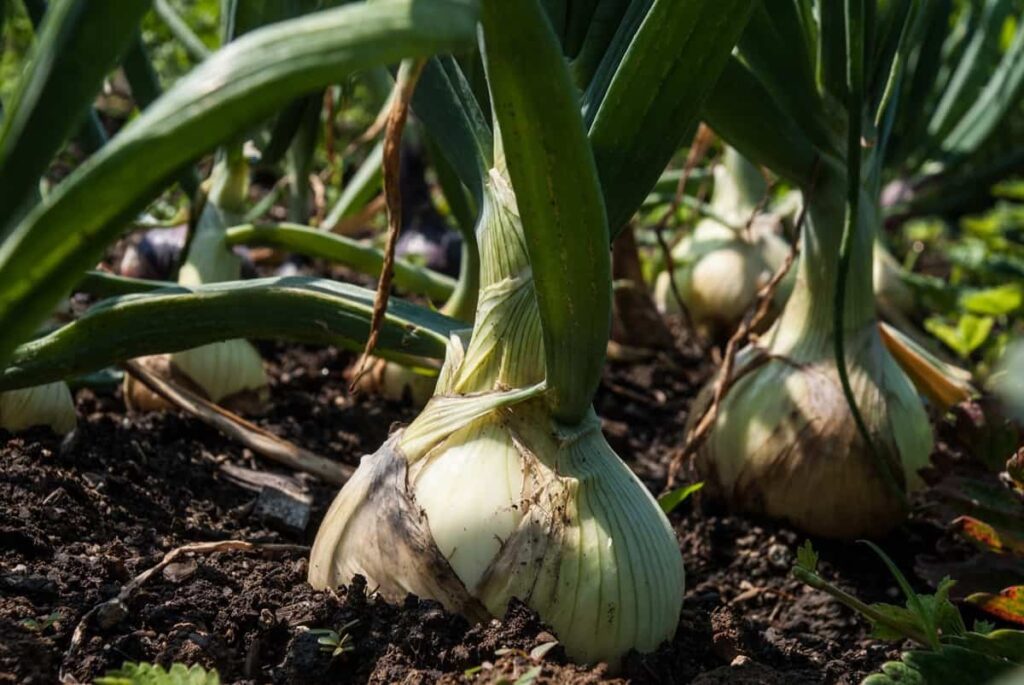
State-wise, Maharashtra, Madhya Pradesh, Karnataka, Gujarat, Rajasthan, Bihar, Andhra Pradesh, Haryana, Uttar Pradesh, Chhattisgarh, West Bengal Odisha, Tamil Nadu, Jharkhand, and Telangana are the biggest onion producers. Maharashtra ranks first in onion production, with a share of 18% in onion productivity.
Satara, Nashik, Jalgaon, Pune, Solapur, and Ahmednagar are the most important onions growing districts in Maharashtra, occupying 94.68 percent of the total area under cultivation. There are pockets in certain parts of the Satara district of the State of Kharif where Rabi onions are the most widely grown.
Growing onions organically in Maharashtra
Government schemes to support organic farming in Maharashtra
Paramparagat Krishi Vikas Yojana (PKVY)
As part of the Paramparagat Krishi Vikas Yojana, cluster-based organic farming is promoted with PGS (Participatory Guarantee System) certification. Several activities are supported under the scheme, including cluster formation, training, certification, and marketing. A farmer receives the assistance of Rs. 20,000 per acre/3 years, of which 60 percent (Rs. 12,000) goes towards organic farm arrangements.
Mission Organic Value Chain Development for North Eastern Region (MOVCDNER)
Through Farmer Producer Organisations (FPOs), the scheme promotes third-party certified organic farming of niche crops in the northeast region. An organic input assistance program provides farmers Rs 10,000 per acre for three years, including organic manure and bio-fertilizers.
Bharatiya Prakritik Krishi Padhati (BPKP)
PKVY has initiated the Bharatiya Prakritik Krishi Padhati (BPKP) program to promote using natural on-farm inputs for chemical-free farming. In addition, a continuous area certification program and support for individual farmer certifications have also been initiated to bring in default organic areas and willing individual farmers.
In case you missed it: Growing Spinach Organically in Telangana: Cultivation Practices and Production Guide
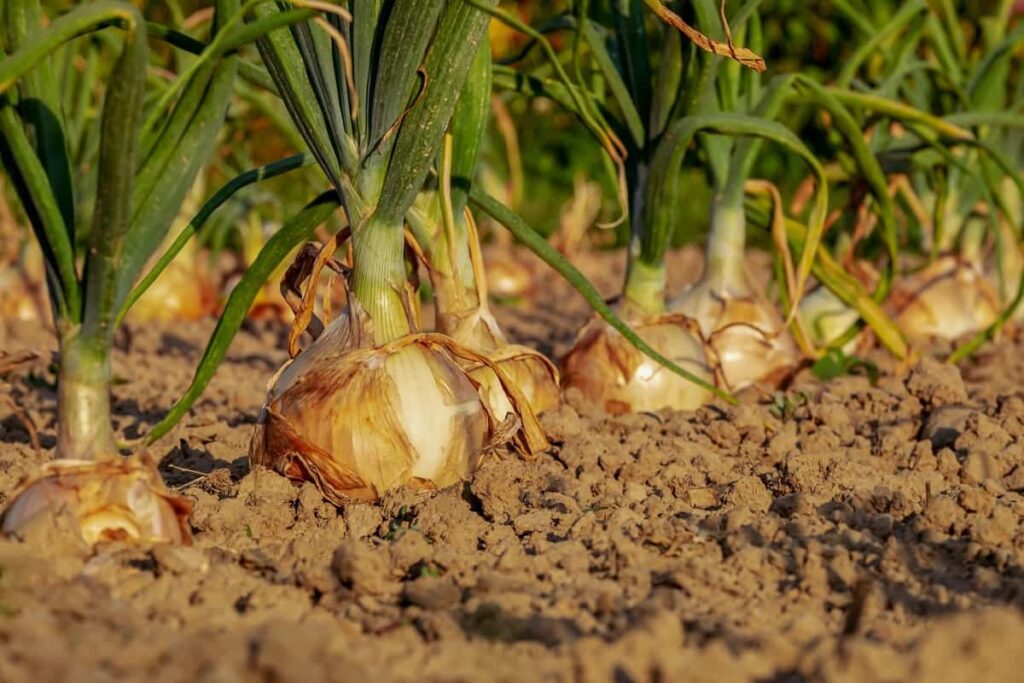
Climate requirements for growing Onions organically
Despite being a temperate crop, onions can grow under various climatic conditions, including temperate, tropical, and subtropical conditions. The best can be achieved when the weather is mild without extremes of cold, heat, or excessive rainfall. Onion plants are hardy and can withstand freezing temperatures in their early stages. Short-day onions are grown in the plains of India and require 10-12 hours of daylight per day. Long-day onions are grown in hills where the length of the day must be 13-14 hours.
For vegetative growth, a low temperature and short day length are required. Conversely, bulb development and maturity require a relatively higher temperature and a longer day length. Plants grow best at 13-24°C during the vegetative phase and 16-25°C during bulb development. Approximately 70% relative humidity is required for good growth. During the monsoon season, it grows well in places with an average rainfall of 650-750 mm. A rain-fed crop cannot be grown in areas with low rainfall (less than 650 mm) or heavy rainfall (more than 750 mm).
Soil requirements for growing Onions organically
Various soil types can be used to grow onions, including sandy loams, clay loams, silt loams, and heavy soils. It is best to cultivate onions on deep, friable, alluvial soils with good drainage, moisture-holding capacity, and sufficient organic matter. Bulbs can be deformed in heavy soils. However, onions can be grown successfully on heavy soil when organic manure is applied before planting, and the field preparation for onion cultivation should be excellent.
Ideally, onions should be planted in soils with a pH range of 6.0 to 7.5, but they can also be grown in mildly alkaline soils. Water logging conditions and highly acidic, alkali, or saline soils are more harmful to onion crops. A pH below 6.0 does not allow onions to thrive because of trace element deficiencies or, occasionally, Al or Mn toxicity. For onion crops, the threshold electrical conductivity of a saturation extract (ECe) is 4.0 dS/m. Crop yield begins to decline when ECe levels exceed this.
Season, sowing, transplanting, and harvesting timings of Onion in Maharashtra
| Season | Time of seed sowing | Time of transplanting | Time of harvesting |
| Early Kharif | Feb to Mar | Apr to May | Aug to Sep |
| Kharif | May to June | July to Aug | Oct to Dec |
| Late Kharif | Aug to Sep | Oct to Nov | Jan to Mar |
| Rabi | Oct to Nov | Dec to Jan | Apr to May |
Onion varieties growing in Maharashtra
- Multiplier Onion: Co1, Co2, MDU 1, Agrifound Red
- Small Common Onion: Agrifound Rose, Arka Bindu
- White Onion: Bhima Safed, Pusa White Round, Bhima Shubra, Bhima Shweta, Arka Yojith, Pusa White Flat, Agrifound White, Udaipur 102, Phule Safed, N25791.
- Spanish Brown: Bhima Light Red, Bhima Kiran, Phule Suvarna, Arka Niketan, Arka Kirthiman
- Red onion: Bhima Dark Red, Bhima Super, Bhima Red, Bhima Raj, Bhima Shakti, Punjab Selection, Pusa Red, N2-4-1, Pusa Madhavi, Arka Kalyan, Arka Lalima.
In case you missed it: Fertilizer Schedule for Okra: Organic, Chemical, How and When to Apply
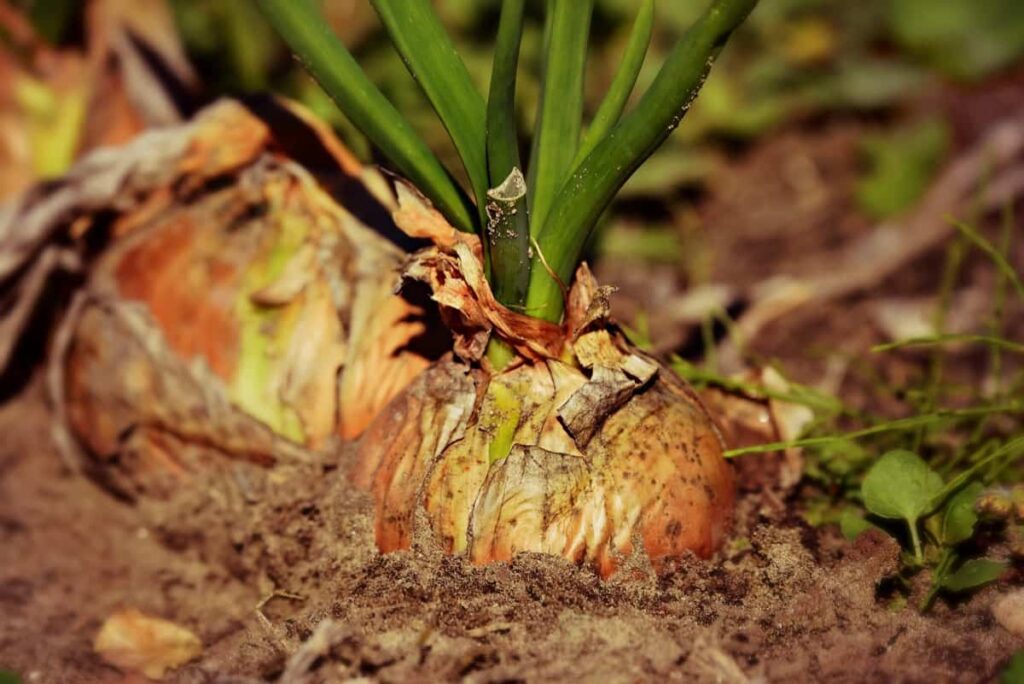
Soil preparation
Approximately 200 square meters of nursery bed area can transplant seedlings in one acre. Plowing the field five to six times to break clods and well-pulverize it to prevent it from drying out is recommended. Before preparing the bed, removing debris, weeds, and stones from the previous crops is important. Mix half a ton of well-decomposed farmyard manure (FYM) with the soil after the last plowing.
It may be convenient to prepare a raised bed with a height of 10-15 cm, a width of 1.0 – 1.2 m, and a length of 1.0 – 1.2 m to raise the nursery. A distance of at least 30 cm should be maintained between beds to ensure uniform water movement and drainage of excess water. Raised beds are recommended for nurseries because flatbeds allow water to move from one end to another, washing seeds away.
Water drainage is another major problem with flatbed seedling raising. For one acre of seedlings, two to three kilograms of seeds are required. Sowing seeds 50 to 75 mm apart is recommended so they can be transplanted easily, weeded quickly, sprayed with pesticides, etc. A thin layer of fine powdered farmyard manure or compost should be applied to the seeds after they have been sown, followed by light watering.
Transplanting Onion seedlings
The selection of seedlings for transplanting should be made with the utmost care. Seedlings that are over- or under-aged should be avoided for better establishment. It is recommended to cut one-third of the seedling top at the time of transplanting to ensure the good establishment of the seedling. Ideally, rows should be spaced 15 cm apart, and plants should be separated by 10 cm.
Broadcasting in Beds/Direct sowing
Chitradurga, Bellary, and Dharwar districts of Karnataka sow big onion seeds directly in lines (30 cm apart), which are thinned later to ensure proper spacing for bulb development. In small flat beds, seeds of small onions (Agrifound Rose, Bangalore Rose, and Arka Bindu) are broadcast and thinned later. 8 to 10 kg of seeds per acre is used for broadcasting directly in the field or sowing in rows.
During September-October, seeds are sown in lines 30 cm apart on the plains. To reach a depth of 2.5 to 3 cm after sowing, the seeds must be hoed by hand after sowing. Light irrigation or hand watering should be given immediately after the seeds have been covered. A ten-day interval between weeding and planting is recommended to prevent seedlings from smothered.
Irrigation requirements for growing Onions organically
Depending on the season, soil type, irrigation method, and crop age, onions require irrigation. As soon as the onion is transplanted, three days after transplanting, and then every seven to ten days after that, depending on soil moisture, the onion needs irrigation. Kharif crops require 5-8 irrigations, late Kharif crops need 10-12 irrigations, and Rabi crops need 12-15 irrigations. Because onions have shallow roots, they require frequent light irrigation for proper growth and bulb development.
When the crop reaches maturity (10-15 days before harvest), irrigation should be stopped. Modern irrigation techniques such as drip and micro sprinkler irrigation can save irrigation water and increase marketable bulb yields. For example, researchers found that drip irrigation with 100% Pan Evaporation (PE) significantly improved marketable bulb yield (15-25%), water savings of about 35-40%, and labor savings of 25-30% compared to flood irrigation.
In case you missed it: Fertilizer Schedule for Home Garden: Organic, Chemical, How and When to Apply
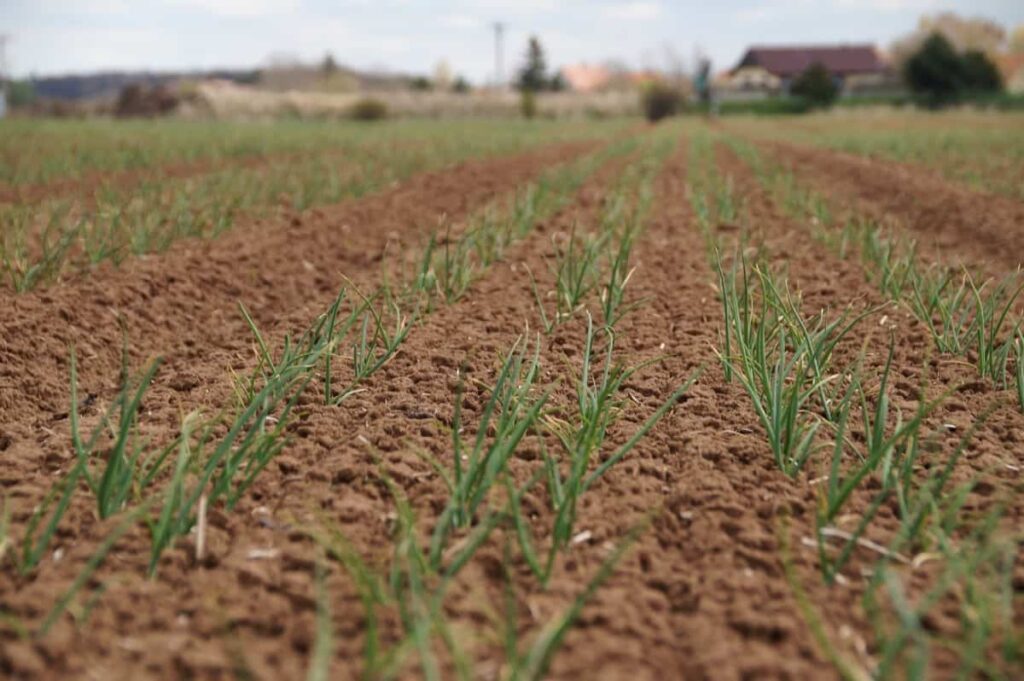
Fertilization requirements for growing Onions organically
Onion requires a high source of nitrogen. The amount of manure and fertilizer depends on the climate and soil type. The response of onion crops to manure depends on N availability for crop growth. N availability from manure varies greatly depending on the type of animal, type and amount of bedding, and age and storage conditions of the manure. Long-term manure application based on N can accumulate other nutrients such as P and K in soil and eventually reach excessive levels.
Further, over-applying manure may also increase the risk of contaminating surface or groundwater with P. Yield response to compost is greater in soils with low fertility. Still, response varies depending on the compost source. For example, when onion plants were grown in plots of sandy loam soil, compost applied over two years at cumulative totals of 15 tons per acre increased marketable yield.
Weed control
Because onion crops don’t compete well with weeds, they tend to have successive flushes of weeds and narrow upright leaves that don’t shade weeds emerging from the rows. Without control, weeds may completely suppress the crop by competing with nutrients, moisture, and space. Moreover, they are susceptible to pests and diseases, which can reduce yields significantly. Onion crops grown organically can benefit from the following cultural practices to manage weeds,
- Using seeds that are free from weed seeds
- Planting early maturing onion varieties
- Crop rotation
- Using water for irrigation that is free from weed seeds and mulching
- Hand pulling/uprooting the weeds
Pests in Onion crops
| Pests | Symptoms | Control |
Onion thrips | 1. The feeding area appears white to silvery in color. 2. Tiny black “tar” spots of thrips excrement | 1. Conserve predators such as syrphid flies, minute pirate bugs, lacewings, and spiders. 2. Sprays spinosad, azadirachtin, and Beauveria bassiana. |
| Red spider mite | 1. Silk webbing on leaves 2. leaves become bleached and discolored and may fall off. | 1. A thorough water spray washes off the mites from the plant. 2. Conserve predators such as anthocorid bugs, mirid bugs, green lacewings, predatory mites, and spiders. |
| Eriophyid mite | 1. Stunting, twisting, curling, and discoloration of foliage 2. Scarification and drying of bulb tissue | 1. Spray with horticultural oils or insecticidal soaps 7-10 days before bud break to kill overwintering adults 2. Spray with wettable sulfur or apply sulfur dust. |
In case you missed it: Fertilizer Schedule for Fruits: Organic, Chemical, How and When to Apply
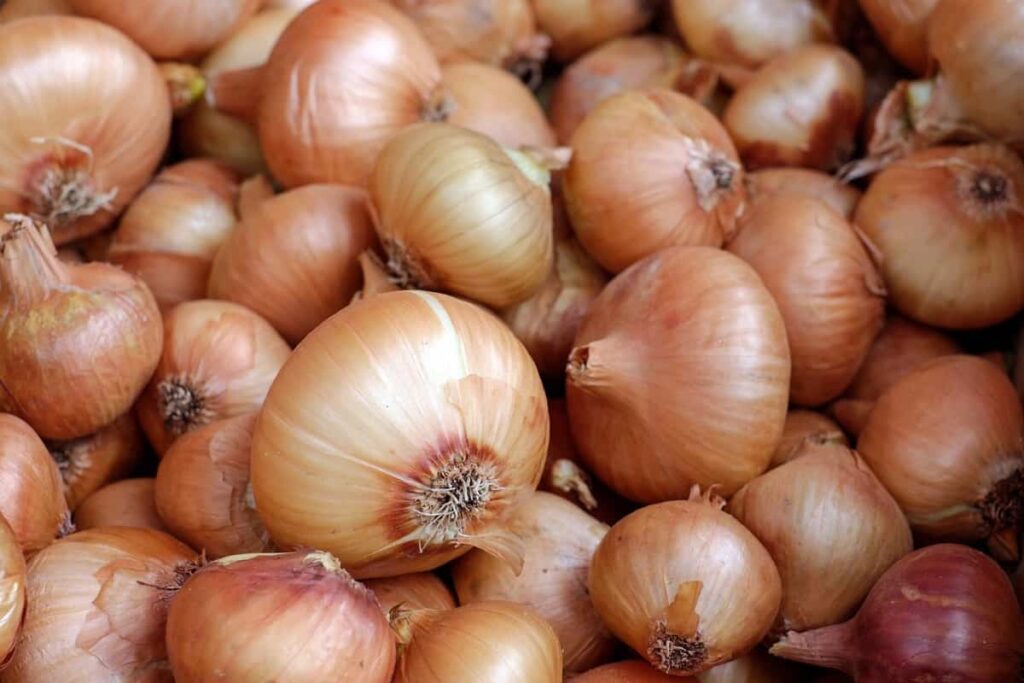
Diseases in Onion crops
| Disease | Symptoms | Control |
Purple blotch | 1. Leaves and flower stalks as small, sunken, whitish flecks with purple-colored centers. 2. The lesions may encircle leaves/stalks and cause their drooping | 1. Use healthy seeds for planting 2. Follow proper drainage at regular intervals |
White rot | 1. Yellowing and dieback of leaf tips 2. The bulbs become soft and water soaked. | 1. Follow crop rotation with cereal crops. 2. Hot water treatment of bulbs at 49 °C. |
Pink root rot | 1. Roots turn pink or maroon when infected. 2. Roots may die, and the plants become weakened or stunted | 1. Soil solarization reduces pink root incidence. 2. Late planting reduces disease incidence. |
Harvesting Onions
Depending on the purpose for which onions are planted, onions are harvested differently. Onion crops are ready for harvesting after five months for dry onions. The crop becomes ready for marketing as a green onion three months after transplanting. After onions form their bulbs from their leaf bases, the leafy green tops turn yellow and collapse a little above the top of the bulb, leaving an upright short neck.
In case you missed it: Top 15 Effective Organic Home Remedies for Garden Pests: Proven Control Methods
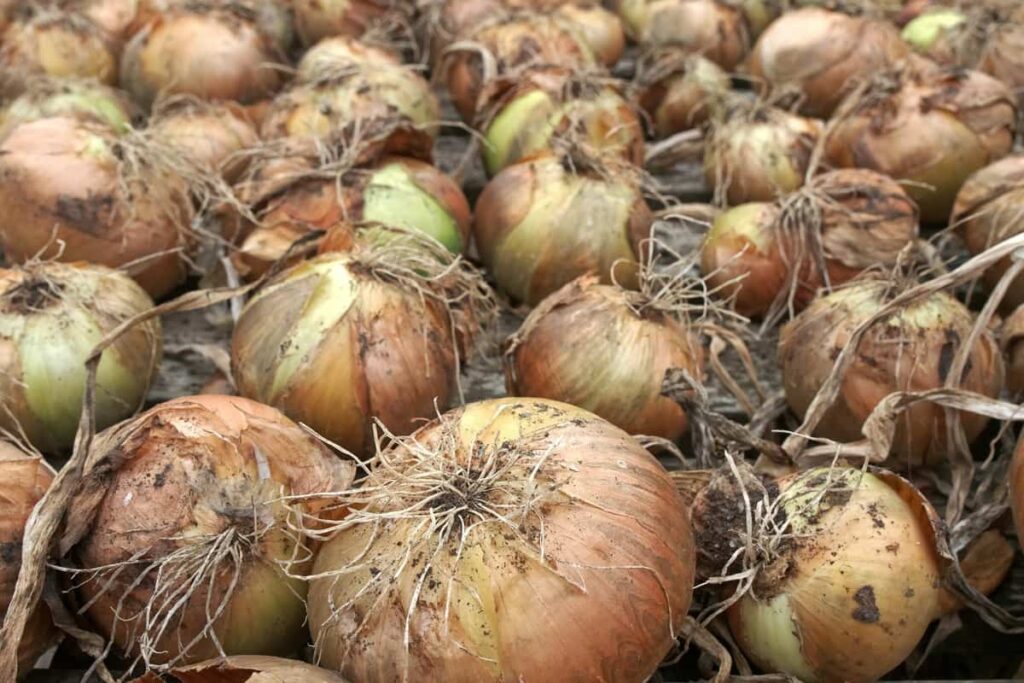
The bulbs are ready for harvest when the tops “go down” in this way. Since tops do not fall during Kharif, bulbs are harvested shortly after the color of leaves changes to slightly yellow, and red pigmentation appears on buds. Therefore, the best time to harvest rabi onions is one week after 50% of the tops have fallen over. As onion bulbs typically form at the surface of the soil, it is sometimes possible to pull mature bulbs by hand in sandy soils.
A fork or hoe is used to loosen the bulbs before lifting them when hand pulling is impossible. Windrows are left in the field until the tops of the harvested crop are dry. It is important to make the windrows so that the green tops cover the bulbs to protect them from sunburn. Once the leaves are completely dried, they are cut about 2 to 2 1/2 cm above the bulb. This practice can increase dry matter content.
Yield from organic Onion crops
Depending on the variety and season, onions produce varying yields. In the rabi season, irrigated onion crops yield 10-12 tons per acre, while rainfed crops yield only 300 to 400 kg per acre. Sugarcane and turmeric intercropped with onion in alleys of young fruit gardens and banana gardens yield 2-3.5 tons per acre. The small, pungent, local cluster onions yield half as much compared to the large varieties.
Conclusion
Compared to the conventional plots, onions grown in the organic plots had lower yields and higher levels of antioxidants, including total phenol, flavonoid, ascorbic acid, and quercetin-3-glucoside. The principal Onion growing districts in the Maharashtra State are Satara, Nashik, Jalgaon, Pune, Solapur, and Ahmednagar, occupying about 94.68 percent of the area under cultivation Onion in the State.
- Management Pests and Diseases in Your Cotton Field
- Sheep Farming Business Plan for Beginners
- Aquaponic Farming at Home: A Step-By-Step Guide
- Profitable Village Farming Business Ideas in 2024
- High-Yield Aquaculture: Fast-Growing Fish for Farming
- Effective Fish Pond Construction Techniques for Beginners
- Irrigation and Water Management in Pineapple Farming
- Blossom to Harvest: Mastering Flowering and Pollination in Papaya Farming
- Pig Fattening Essentials: From Selection to Sale for Beginners
- Raising Wagyu Cattle: A Complete Guide for Premium Beef Production
- Soil Types and Their Water Holding Capacity
- Optimizing Irrigation Schedules for Coconut Groves for Enhanced Yield
- Espresso Your Garden: Coffee Grounds for Healthier Acid-Loving Plants
- The Best Soil Mix for Snake Plants: How to Mix Your Own Snake Plant Soil
- Green Thumb Success: Expert Tips for Cultivating Greenhouse Beans All Year Round
- Bloom All Year Round: The Ultimate Guide to Indoor Hyacinth Care
- Eco-Friendly Gardening: How to Make Liquid Fertilizer from Kitchen Waste
- Ultimate Guide to Grow Anise in Pots: Explore Seed Propagation to Harvesting
- Guide to Raising Chester White Pigs: Discover Breed Facts to Growth Management
- Mastering the Elegance: The Ultimate Guide to Weeping Cherry Tree Care, Planting, and Maintenance
- Ultimate Guide to Planting Garlic in Grow Bags: Growing Strategies for Beginners
- How to Fix Spider Plant Leaf-Related Problems: Natural and Organic Remedies
- 10 Reasons Why Your Tulsi Plant is Shedding Leaves: Home Remedies and Solutions
- Optimizing Growth and Yield: The Advantages of Palm Bunch Ash Fertilizer
- Utilizing Neem Oil Extract as a Natural Pesticide for Hydrangea
- From Soil to Harvest: Various Ways in Which Farmers Can Use AI Tools
- Steps to Encourage and Induce Citrus Flowers: A Comprehensive Guide
- How to Fix Snake Plant Leaf-Related Issues: Natural and Organic Remedies
- Transform Your Garden into a Fragrant Oasis with Raat Ki Rani (Night Blooming Jasmine)
- Discover the Ideal Chicken Breeds for Philippine Farms
- How to Create a Poultry Egg Farm Business Plan for Profits
- Grow Lemon Cucumbers Like a Pro: Insider Techniques for Bountiful Yields
- Ultimate Guide to Caring for Your Pink Princess Philodendron: Tips for Thriving Variegation
- Areca Nut Profit Per Acre: Calculating Yield and Cost of Cultivation
- How Kaveri Chicken is Becoming a More Profitable Breed in Indian Backyards
- Transform Your Barn: 9 Steps to Convert a Horse Stall into a Chicken Coop
